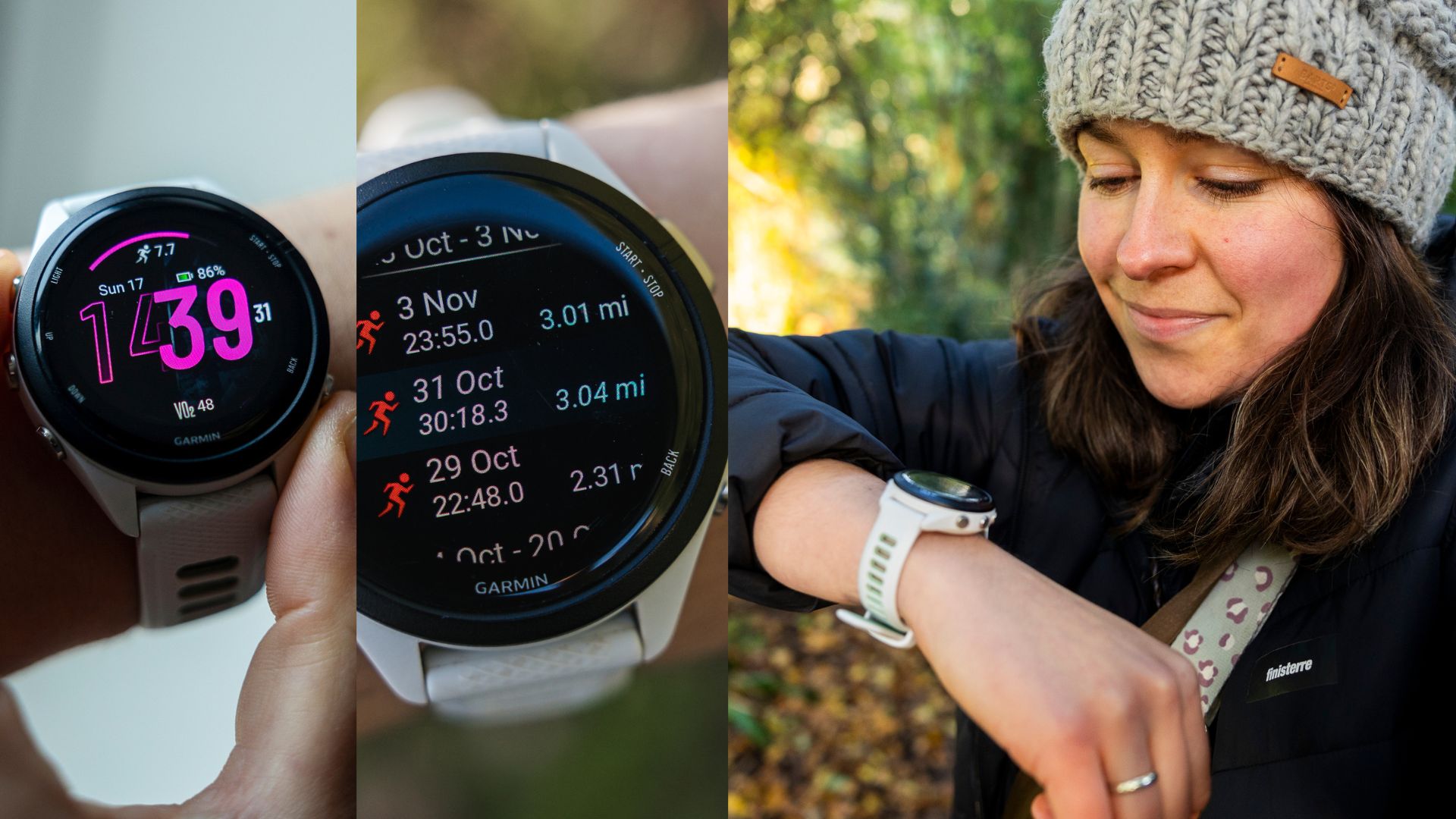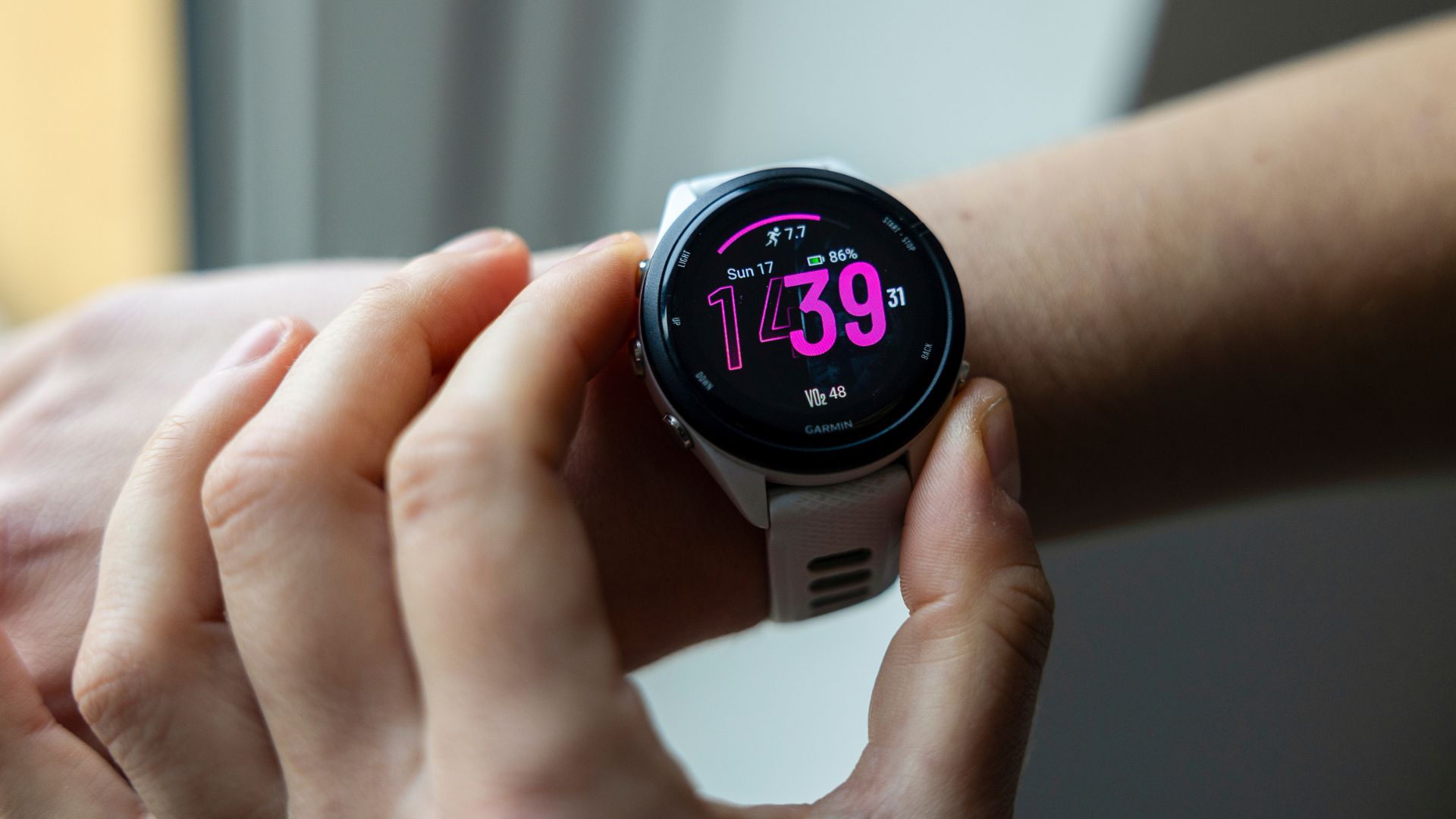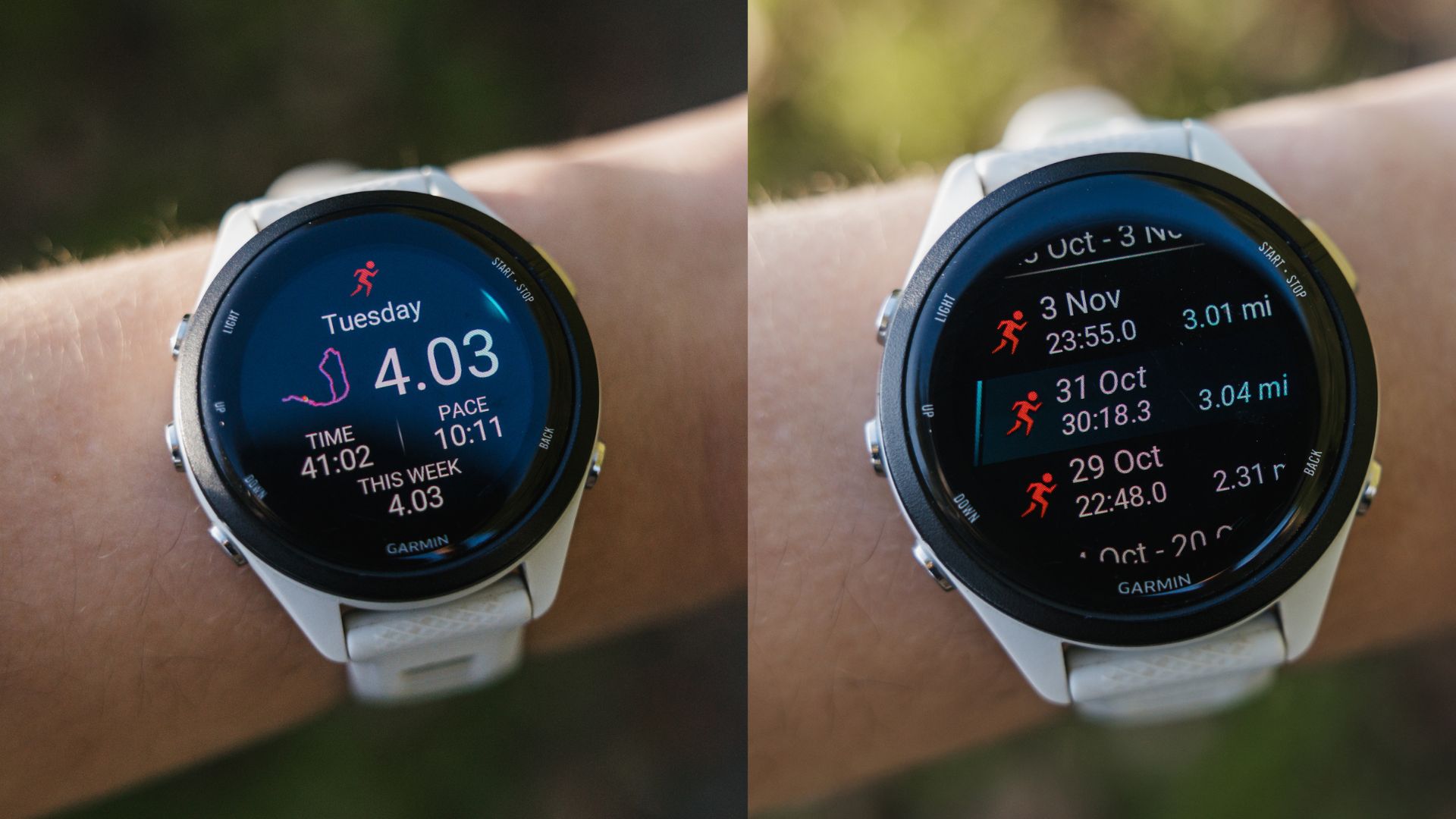Garmin Forerunner 265 review: I've worn this tracker for 6 months - here's why it's almost the perfect running watch for women
The Garmin Forerunner 265S is the brand's smaller running watch aimed at helping you train faster and smarter. It's a brilliant running tool for women but comes at a price

Garmin's smaller-sized Forerunner 265S smartwatch is perfect for women serious about running and tracking their fitness metrics. The vibrant AMOLED touchscreen makes navigation quicker and prettier than its predecessor, and Garmin's in-depth insights help you prepare, plan and perform for your best runs yet. I found the heart rate tracking more hit-and-miss than a tracker of this price should reasonably be, but it's transformed my runs, and I won't be taking it off soon.
-
+
Compact design for small wrists
-
+
Multi-band GPS for accurate tracking
-
+
Gorgeous AMOLED touchscreen
-
-
I found heart rate data inconsistent
-
-
Costs much more than its predecessor
-
-
No map functionality
Why you can trust Woman & Home

The Garmin Forerunner 265S is one of the brand's more advanced smartwatches for runners. It offers personalised coaching plans to help you improve your performance and a range of daily health-tracking features to monitor your overall wellbeing. Released in early 2023 alongside the slightly bigger 265, its compact design makes it a comfortable choice for women with smaller wrists.
Earlier this year, fed up with having to charge my Apple Watch every night and wanting to take my running more seriously again, I bought the Garmin Forerunner 265S. On paper, it's the best Garmin watch for runners, with a long battery life, accurate GPS and onboard music. But how does it perform in real life? And how do its general fitness tracking features shape up?
If you're wondering which Garmin is right for you and the Forerunner 265S is on your shortlist, read on. I've worn the 265S almost every day for over six months, running for over 30 hours and 200 miles on roads, trails and in competitive races. These are my honest thoughts and findings to help you decide.
Garmin Forerunner 265S review
Garmin Forerunner 265S: Overview
Garmin released the Forerunner 265S in spring 2023 as the next generation from the mid-range Garmin Forerunner 255 smartwatch (still currently on sale). It has a sharper, brighter screen, a battery life of two weeks in smartwatch mode and daily training insights designed to offer you a personalised coach on your wrist. Unlike the 255, the 265S also comes with music built-in as standard.
Although the Forerunner is designed for runners, there are over 30 activities onboarded - including cycling, open-water swimming, strength training and yoga. It's best described as the 'Goldilocks' of Garmin's current running watch lineup - not as expensive as its rugged Fenix series, but with more data chops than the lifestyle-friendly Venu (more on Garmin Venu vs Forerunner here) series.
The Forerunner 265S can measure daily health signals like sleep, heart rate variability, and stress, and it has some basic smart features like answering calls. However, it comes into its own for runners like me who love stats and are looking for deeper training insights to see how all that pavement pounding adds up over time.
What I like about Garmin is that once you've bought a device, you don't get hit by monthly subscriptions to access the most useful features - unlike the WHOOP 4.0 or the Oura Ring. As with all Garmin watches, you'll sign up for the free Garmin Connect app (Android and iOS) and connect the 265S to view your fitness data and make the most of it. The Connect app is sensibly laid out for beginners and advanced users, even though the black and grey interface is a little boring.
Sign up to our free daily email for the latest royal and entertainment news, interesting opinion, expert advice on styling and beauty trends, and no-nonsense guides to the health and wellness questions you want answered.
Garmin Forerunner 265S: Specifications
Spec | Forerunner 265S | Forerunner 265 |
|---|---|---|
RRP | £429 | £429 |
Size | 42 x 42 x 13 (mm) | 46 x 46 x 13 (mm) |
Weight | 39 g | 47 g |
Materials | Silicone strap, Corning Gorilla Glass 3 screen, polymer bezel | Silicone strap, Corning Gorilla Glass 3 screen, polymer bezel |
Screen | 360 x 360 px AMOLED touchscreen | 416 x 416 px AMOLED touchscreen |
Battery life | 15 days (smartwatch mode), up to 6 hours with GPS and music playback | 13 days (smartwatch mode), up to 6 hours with GPS and music playback |
GPS | GPS, GLONASS, GALILEO, SATIQ | GPS, GLONASS, GALILEO, SATIQ |
Waterproof | 5 ATM (50 metres) | 5 ATM (50 metres) |
Who is the Garmin Forerunner 265S suited to?
While the Forerunner 265S can often be found in a Garmin sale, it's still more expensive than the best Fitbits. For this reason, I'd recommend the Forerunner 265S to runners taking on fitness challenges and races, who want help improving their times and performance and are happy to pay more for advanced features like Garmin's coaching, training plans and guided runs.
The Garmin app has more insights than some users will ever need or look at. If you're new to the Garmin ecosystem, I think it takes a few weeks to understand and fully interpret your stats, and see those all-important metrics change over time.
If you're looking for a simpler smartwatch that integrates seamlessly with your phone, the Garmin Forerunner 265S might not be best suited to you. It does give you alerts for calls, texts, and emails on your wrist - and it's easy to customise what you get pinged for - but I've found the "smart" experience more basic than my Apple Watch Series 9.
If you're after the richest smartphone experience and fitness is just a bonus rather than the main event, I'd recommend matching your watch to your phone. Apple Watch to iPhone, Google Pixel Watch 3 to Pixel phone – you get the idea.

The Garmin Forerunner 265S is smaller than the regular version, perfect for anyone who wants a smaller fitness tracker on their wrist.
Garmin Forerunner 265S: Design
The Forerunner 265S is a smaller but almost identical version of the standard 265 model. It's a big upgrade on the previous Forerunner 255, the biggest difference between these two generations being the new display. The 265S has a bright AMOLED touchscreen that's easier to view in sunlight, tap while training and navigate around to view your stats.
The 265S' 360 x 360 px AMOLED is simply gorgeous. You can customise the standby watch face with accent colours and styles, and surface the info that's most important for you to have at a glance. It's also worth pointing out how hard-wearing the Corning Gorilla Glass lens is. After six months of trail runs, drops and dog chews, there's not a scratch on my screen.
Having used my partner's entry-level Garmin Forerunner 55 without a touchscreen, I can attest to how much time and frustration you save by being able to scroll around the watch's menus rather than only using physical buttons. There are still five buttons around the bezel though, including a larger, raised 'Run' button top right which is welcome during a run for starting or pausing an activity – especially if you're wearing gloves or out in the rain.
The 265S has a flexible silicone strap that's comfortable to wear while sleeping, training and generally living. I barely take the watch off, except to charge it, and don't have any skin complaints from the strap material. Like most Garmin watches, it's easy to customise the look of the 265S by swapping the strap. Remove the band using the quick-release pin and you can choose from a huge range of official and unofficial options.
Running with Garmin Forerunner 265S
I've recorded over 30 hours of running with the Garmin Forerunner 265S, in half-marathon, 10K and 5K race settings, on countryside trails with my dog and for regular road routes around my home city. I've put it through its paces in a variety of settings and made it my mission to use every single running feature at least once.
To start a run with the Forerunner 265S, it's as easy as pressing the Run button on the side, waiting for the GPS to lock on - lightning fast compared to watches I've used without Multi-band GPS - and pressing the button again to start recording. On the screen, you'll see your time, distance, pace, and heart rate by default, and scrolling gives you lap times. After a few minutes of running, you also get an analysis of your Performance Condition for a real-time assessment of how you're doing.
It's not always easy knowing how far and fast you should run on any given day. That's where Garmin's suggested runs come in, appearing when you've been wearing the watch long enough for it to profile you. Setting up a training plan in the Connect App also gives you a suggested run based on how long away your race is, and what part of the plan you're in.
With these guided runs, the watch aims to keep you within a certain pace to benefit your long-term performance (and alerts you when you're outside of this). On one day, I'd have a slow and steady run to maintain long-term fitness, while repeated sprint intervals on another day were designed to improve my cardiovascular health.

The Garmin Forerunner 265S is perfect for runners but each workout mode has specific stats relevant to the individual exercise.
When you've finished a run, an in-depth session analysis is in the Connect App, where you'll see yet more stats on your pacing, speed, running power and training effect. You can also connect the 265S to third-party running apps like Strava, which often shows similar data in a more user-friendly way.
Having such an intelligent system in the Forerunner 265S has genuinely improved my performance, and taken a lot of the thought out of how I should run. I used to jog fairly randomly with my Apple Watch, with little to tell me whether it had been better, worse or about the same as a previous run. But the Forerunner 265 pushes me to sprint harder and run further than I would have done before. It also recommends rest days after I've pushed myself. As someone who's previously overtrained and suffered from exhaustion, the balanced approach the 265S gives me is for my long-term running fitness, not just short-term gains.
Of course, the 265S isn't the top-tier running watch from Garmin. It misses a few tricks, including the Forerunner 965's advanced built-in maps - but does give you a basic electronic breadcrumb trail during activities like hikes. Several apps in the Garmin Connect store can also add maps to the watch, including AllTrails and Komoot. If you're someone who wants to run off the beaten track, the multi-band GPS tracking is more accurate than single-band, but stick it in Auto and Garmin will automatically find the best option for you.
Fitness tracking on the Garmin Forerunner 265S
The Forerunner 265S is a running watch first, but it also caters to a huge range of indoor and outdoor sports, plus wellness activities like Breathwork. There's even a Triathlon mode, which I found could automatically detect when I transitioned from one section to the next.
Starting any session is done with the run button and scrolling down, and you can customise your list of favourite activities so they're quick to access. For me, that's Strength, HIIT and Pool Swim. So many fitness trackers fail to offer useful insights during a workout, and with the Forerunner 265S, I like that what you're shown on screen is relevant for each activity. For yoga, where the whole point is slowed relaxation, you see your stress level and respiration rate. For Strength, it's reps. Like your runs, fitness sessions are automatically synced to the Garmin Connect app once finished.
The Forerunner 265S might offer many fitness tracking options, but it misses out on the preloaded workouts and on-screen exercise animations of the Garmin Venu 3S. This isn't a dealbreaker for me, as I mainly use the FiiT app on my phone for follow-along HIIT classes, but it might be a drawback for those new to certain workouts.
However you're training, the 265S will show you how it affects you and how your body reacts to it. New for the 265S over the 255 (and other advanced Garmin watches like the Fenix 7) is Garmin's Training Readiness Score. It's essentially a mark out of 100 on how prepared you are to perform that day.

The AMOLED screen on the Forerunner 265S (left) is a huge upgrade from older watches like the Garmin Forerunner 45 (right).
Similarly, Garmin’s Body Battery gives you another 1-100 score indicating your general energy levels for any given day and time. Then there's the Training Status tab, which will tell you whether your recent activity efforts have been productive, maintained your fitness or even strained your body. By understanding my body's readiness, I've made more informed decisions about my training schedule, and whether I need a high-intensity session, or a low-impact recovery walk with my dog.
Despite how much my Forerunner 265S has helped my fitness, it does have a major flaw. I've noticed the heart rate tracking is glitchy for some workouts, getting stuck on the same number for up to five minutes until I pause the activity, rejiggle the watch on my wrist, and give it a chance to catch up.
I've also noticed that Garmin's "effort algorithms" seem to favour high heart rate activities like running, but treat activities in a lower zone as if nothing much happened. It's rare for my heart rate to reach over 120 bpm while strength training and a current limitation of how effort is recorded on the watch is that heavy lifting doesn't affect my training readiness as much as a run. I certainly feel tired and sore the next day, but Garmin thinks I'm ready for a big dash in my trainers.
Sleep tracking on the Garmin Forerunner 265S
The Garmin Forerunner 265S is designed to be worn every night and has advanced sleep-tracking sensors as well as nap detection (which I can attest to working, almost scarily well). I always take sleep tracking with a pinch of salt, however, I found that Garmin's sleep score correlated with how I felt I'd slept, and how sprightly or sluggish I was during the day.
As with all of Garmin's tracking metrics, you can view basic sleep information – your overall duration, score and sleep stages – on the watch itself, while a wealth of data and information awaits further analysis in the Connect app. Aside from just giving you data, I like that the app delves into your sleep score factors, explaining why Light, Deep, and REM sleep is important, what it's for and how much the optimum amount is. I felt like I was learning a lot about health in general by delving into this section.
On the other hand, I think Garmin's Sleep Coach needs more work in this direction. On most days it either tells me I need 8 hours exactly, or half an hour over or under, with repetitive phrases explaining why. Given how much Garmin's training coaching has come on in the last few hours, I've no doubt they can bring sleep coaching to a similar standard, but it's just a shame it doesn't yet compete with the Oura Ring for features like Bedtime Guidance.

Garmin's sleep tracking and body battery score can offer an idea of how well you're recovering from exercise and daily movement.
Is the Garmin Forerunner 265S worth it?
I've run regularly for over a decade - at varying levels of seriousness - but I've only taken trackers and watches seriously in the last few years. The Forerunner 265S is finally proof that you can have a good-looking watch, solid tools for better health and enough battery for real off-grid adventures. I found battery life a standout compared to the daily charge of an Apple watch, and even with music and GPS enabled you can get a marathon out of the device. Plus, a full charge takes just over an hour.
For women specifically, given our naturally smaller wrists, the size of the Forerunner 265S is more manageable than the brand's chunkier watches. The onboard Women's Health app lets you view and log cycle information from your wrist and adapt your training depending on your menstrual cycle. You can also pause training altogether, should you feel like you need a break.
There's a saying out there that goes "What gets measured gets managed", meaning that when you have data on something, it can increase your understanding and motivation to make positive changes. I've always believed that health is something we can also measure holistically - how we feel rather than what numbers say - but there's no denying that the Forerunner 265S helps you to reach specific running goals.
The 265S provides data in spades and justifies its price point for the guidance it gives you to become a better athlete - without mindlessly pushing you. It's helped me to get my best 5K time for a decade, train quickly for a half marathon, and take my stress levels more seriously with regular yoga and meditation. If you're looking for a reliable and feature-rich running watch that can handle your daily needs, the Garmin Forerunner 265S is absolutely worth it.
Should you buy it? | It's worth it if | It might not be worth it if |
|---|---|---|
Usage type | You're looking for a watch that you don't have to charge daily. | You want to be able to control lots of apps on your phone from the watch. |
Running level | You're a runner looking to improve your race times, run further and get guidance on how far and fast you should run. | You're an occasional runner and want basic fitness data like steps and heart rate. |
Design | You want a low-profile device that also has a bright, crisp screen. | You're not bothered about having the latest AMOLED screen. |
Garmin Forerunner 265S vs 265
There are two models for this device: Garmin Forerunner 265S and 265. The 'S' here stands for 'small', with the 265 having a larger case size of 46mm while the 265S is 42mm.
Despite being smaller, the 265S boasts a slightly better battery life. Garmin says the battery life is up to 15 days in smartwatch mode, 6 hours if you have the Multi-Band GPS enabled, plus wrist heart rate tracking and music playback.
Connectivity (Bluetooth, ANT+, Wi-Fi), GPS options and waterproofing are the same for both models.
Lauren is woman&home's Audience Development Manager but has also spent a decade working as a freelance journalist and editor. She is a keen hiker, runner, and vegetable eater, and likes working out the real facts from the fads in the wellness industry (as well as just working out). Her recent health & fitness contributions include reviews of top fitness apps like FiiT and Strava for Tech Radar, and she's also got myriad tech bylines with Stuff Magazine, T3, and Digital Camera World.

